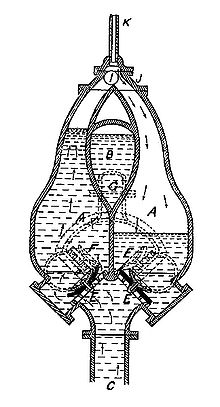|
Pulsometer pump
   The Pulsometer steam pump is a pistonless pump which was patented in 1872[2] by American Charles Henry Hall. In 1875 a British engineer bought the patent rights of the Pulsometer[3] and it was introduced to the market soon thereafter. The invention was inspired by the Savery steam pump invented by Thomas Savery. Around the turn of the century, it was a popular and effective pump for quarry pumping. Construction and operationThis extremely simple pump was made of cast iron, and had no pistons, rods, cylinders, cranks, or flywheels. It operated by the direct action of steam on water. The mechanism consisted of two chambers. As the steam condensed in one chamber, it acted as a suction pump, while in the other chamber, steam was introduced under pressure and so it acted as a force pump. At the end of every stroke, a ball valve consisting of a small brass ball moved slightly, causing the two chambers to swap functions from suction-pump to force-pump and vice versa. The result was that the water was first suction pumped and then force pumped.[4] A good explanation can be found in the 1901 article referenced below:
AdvantagesThe pump ran automatically without attendance. It was praised for its "extreme simplicity of construction, operation, compact form, high efficiency, economy, durability, and adaptability". Later designs were improved upon to enhance efficiency and to make the machine more accessible for inspection and repairs, thus reducing maintenance costs.[5] Detailed analysisIn the January 1901 issue of Technology Quarterly and Proceedings of the Society of Arts, an article appeared by Joseph C. Riley[6] describing key operational details and technical evaluation of the pulsometer pump's performance. Riley noted that although somewhat inefficient, the pulsometer's simplicity and robust construction made it well suited to pumping "thick liquids or semi-fluids, such as heavy syrups, or even liquid mud".[7] Pulsometer Engineering Company LimitedPulsometer Engineering Company Limited was founded in Britain in 1875 after a British engineer bought the patent rights of the pulsometer pump from Thomas Hall. In 1901 the company moved from London to Reading, Berkshire. In 1961 Pulsometer merged with Sigmund Pumps of Gateshead to form Sigmund Pulsometer Pumps. SPP Pumps Ltd became one of the largest pump companies in Europe. SPP Pumps Ltd is now part of Kirloskar Brothers Ltd. References
|